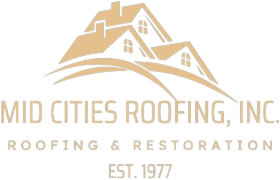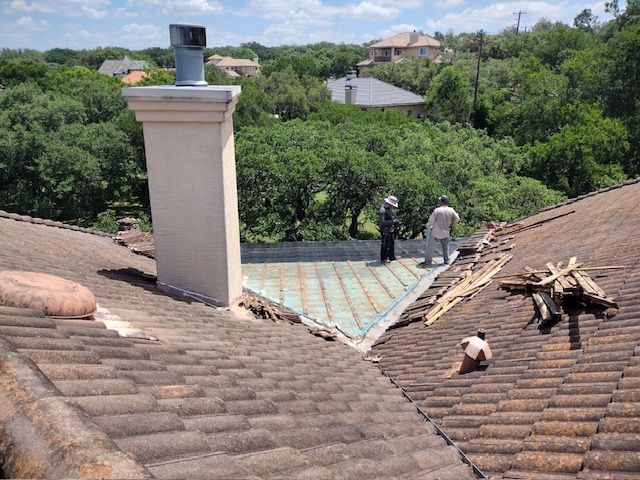Texas is known for its scorching summers, with temperatures regularly exceeding 100°F. While this heat might be great for a day at the lake or a backyard barbecue, it can be brutal on your roof. Extreme heat, UV exposure, and thermal expansion can cause serious roofing problems if left unchecked.
In this guide, we’ll break down the ways Texas heat impacts your roof, what warning signs to look for, and how you can protect your home from costly damage.
How Extreme Heat Impacts Your Roof
UV Radiation Weakens Roofing Materials
Even on cloudy days, UV radiation from the sun is continuously hitting your roof. Over time, this exposure degrades materials, causing:
- Shingles to become brittle and crack
- Wood roofing structures to dry out and warp
- Roof coatings to fade and lose their protective properties
As roofing materials weaken, they become more susceptible to leaks, missing shingles, and structural damage.
Thermal Expansion and Contraction Leads to Cracks
Texas experiences significant temperature swings between daytime and nighttime. In some regions, the difference can be as much as 30-40 degrees in a single day.
This constant expansion and contraction can cause roofing materials to:
- Shift and pull apart, creating gaps where water can seep in
- Crack, leading to leaks and weakened structural integrity
- Loosen nails, shingles, and flashing
Over time, these issues can worsen, leading to costly repairs or even the need for a full roof replacement.
Heat Accelerates Roof Aging
Roofs in Texas often have a shorter lifespan than those in cooler climates due to prolonged exposure to extreme heat.
For example, an asphalt shingle roof that typically lasts 25-30 years in moderate climates may only last 15-20 years in Texas if not properly maintained.
Attic Heat Build-Up Increases Energy Costs
A poorly ventilated attic can reach temperatures of 150°F or more in the summer. This excessive heat:
- Makes your air conditioning system work harder, increasing energy bills
- Shortens the lifespan of roofing materials by baking them from below
- Contributes to moisture buildup, which can lead to mold and wood rot
Proper attic ventilation is key to preventing this heat buildup and reducing cooling costs.
Hail and Storms Can Exacerbate Damage
Texas heat is often accompanied by severe weather, including hail, thunderstorms, and even tornadoes. When combined with weakened roofing materials, these conditions can cause:
- Shingles to be torn off more easily
- Water intrusion from cracked or damaged surfaces
- Structural weakening over time
Signs of Heat Damage on Your Roof
If your roof has been exposed to extreme Texas heat for years, you may notice:
✅ Cracked or curling shingles – A sign that your roof is drying out and becoming brittle.
✅ Faded or discolored patches – UV rays break down roofing materials, causing fading.
✅ Sagging roof sections – Extreme heat can weaken the underlying structure.
✅ Increased energy bills – A sign that your attic insulation and ventilation may be compromised.
✅ Water stains on ceilings or walls – Possible roof leaks due to heat-induced cracking.
If you notice any of these warning signs, it’s time to take action before the damage worsens.
How to Protect Your Roof from Texas Heat
Schedule Regular Roof Inspections
One of the best ways to prevent heat-related damage is annual or bi-annual roof inspections. A professional roofer can:
✔️ Identify and repair small issues before they become costly problems
✔️ Check for loose or damaged shingles
✔️ Ensure your attic ventilation is working properly
Improve Attic Ventilation
A well-ventilated attic helps regulate temperature and prevents heat buildup. Ensure your attic has:
✔️ Ridge vents and soffit vents to allow hot air to escape
✔️ Proper insulation to keep your home cool
✔️ An attic fan (if necessary) to improve air circulation
Install Heat-Reflective Roofing Materials
Certain roofing materials perform better under extreme heat. If you’re considering a roof replacement, look into:
- Metal roofing – Reflects solar heat and lasts 40+ years
- Tile roofing – Durable and naturally heat-resistant
- Cool roof coatings – Reflects sunlight, reducing heat absorption
Apply a UV-Protective Roof Coating
Adding a UV-resistant sealant or roof coating can help extend the life of your roof. These coatings:
✔️ Reduce surface temperatures by reflecting sunlight
✔️ Protect against UV degradation
✔️ Improve energy efficiency
Keep Your Gutters and Roof Clean
Dirt, leaves, and debris can trap heat and moisture, accelerating roof damage.
- Clean your gutters regularly to prevent water buildup
- Remove debris from your roof to reduce heat absorption
- Trim overhanging tree branches to provide natural shade
Consider Lighter-Colored Roofing Materials
Darker shingles absorb more heat, which can shorten your roof’s lifespan. If you’re installing a new roof, consider:
✅ Light gray
✅ White
✅ Beige or sand-colored shingles
These colors reflect more sunlight and help keep your roof cooler.
Address Minor Repairs Immediately
If you notice small cracks, loose shingles, or leaks, don’t wait. Texas heat can quickly turn a minor issue into a major problem.
Final Thoughts
The Texas sun can be unforgiving, but with proper maintenance, you can protect your roof and extend its lifespan.
✅ Schedule regular inspections
✅ Improve attic ventilation
✅ Choose heat-resistant materials
✅ Apply UV-protective coatings
✅ Keep your roof clean and address small repairs early
By taking these proactive steps, you’ll ensure your roof remains strong, energy-efficient, and capable of withstanding the Texas heat for years to come.






